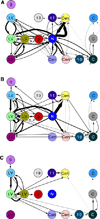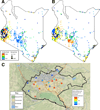Quantifying the impact of human mobility on malaria
- PMID: 23066082
- PMCID: PMC3675794
- DOI: 10.1126/science.1223467
Quantifying the impact of human mobility on malaria
Abstract
Human movements contribute to the transmission of malaria on spatial scales that exceed the limits of mosquito dispersal. Identifying the sources and sinks of imported infections due to human travel and locating high-risk sites of parasite importation could greatly improve malaria control programs. Here, we use spatially explicit mobile phone data and malaria prevalence information from Kenya to identify the dynamics of human carriers that drive parasite importation between regions. Our analysis identifies importation routes that contribute to malaria epidemiology on regional spatial scales.
Figures




References
Publication types
MeSH terms
Grants and funding
LinkOut - more resources
Full Text Sources
Medical

